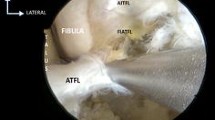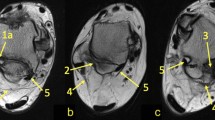Summary
In the literature widely differing statements are found as to the extent of the radiographically seen tilt of the talus after rupture of the fibular ligaments. Our studies on cadavers showed that there can be no exact correlation between the instability found on X-ray investigation and the intraoperatively ascertained damage of the ligamentous structures. The intraoperatively found damage is usually greater than presumed on X-ray investigation. The main reason for these findings is to be seen in the various anatomical shapes of the fibular ligaments. We have certified this in our studies on 20 amputated feet. For clinical purpose it is not of interest which of the ligaments is damaged, but it is of great importance to know whether there is a rupture or not. Anamnesis and clinical state may be important in deciding whether to operate or not.
Zusammenfassung
In der Literatur finden sich sehr unterschiedliche Angaben fur das Ausmaß der Taluskippung nach Verletzung des fibularen Kapsel-Bandapparates am oberen Sprunggelenk. Die von uns an Leichenpräparaten durchgeführten Untersuchungen lassen erkennen, daß eine sichere Beziehung zwischen der röntgenologisch gefundenen Instabilität und den jeweils verletzten Bandstrukturen kaum möglich ist. Dies deckt sich mit unseren Erfahrungen bei der operativen Versorgung frischer fibularer Kapsel-Bandläsionen. Das intraoperativ gefundene Ausmaß der Verletzung ist meist größer, als der preoperative Röntgenbefund vermuten ließ. Eine wesentliche Ursache hierfür dürfte die Vielfalt der anatomischen Variationen des fibularen Bandapparates sein, welche wir an 20 Amputationsprdpäraten gefunden haben. Entscheidend in der täglichen Praxis ist weniger die Frage, welche der drei fibularen Bänder verletzt sind, als vielmehr die Abklärung, ob überhaupt eine Bandverletzung mit Stabilitätsverlust vorliegt. Anamnese and klinischer Befund können in Grenzfällen ausschlaggebend sein.
Similar content being viewed by others
References
Benninghoff A, Goerttler K (1975) Lehrbuch der Anatomie des Menschen, Bd 1. Urban and Schwarzenberg, Berlin
Broström L (1964) Sprained ankles. I. Anatomic lesions in recent sprains. Acta Chir Scand 128:483
Broström L (1965) Sprained ankles. III. Clinical observations in recent ligament ruptures. Acta Chir Scand 130:560
Broström L (1966) Sprained ankles. V. Treatment and prognosis in recent ligament ruptures. Acta Chir Scand 132:537
Buchner H (1960) Zur Supinationssubluxation des Sprungbeins. Arch Orthop Unfallchir 51:680
Dehne E (1933) Die Klinik der frischen and habituellen Adduktionssupinationsdistorsion des Fußes. Dtsch Z Chir 242:40
Dietschi C, Zollinger H (1973) Beitrag zur Diagnostik der lateralen Bandverletzungen des oberen Sprunggelenkes. Z Orthop 111:724
Güttner L (1942) Erkennung and Behandlung des Bänder-risses am äußeren Knöchel mit Teilverrenkung des Sprungbeines im Sinne der Supination. Arch Orthop Unfallchir 41:287
Jend H-H, Daase M, Heller M, Holzrichter D (1983) Zur Diagnostik von Bandverletzungen des oberen Sprunggelenks mit gedriickten Aufnahmen. ROFO 139:5
Kaufmann C (1922) Die Verstauchung der großen Extremitätengelenke. Schweiz Med Wochenschr 3:737
Lang J, Wachsmuth W (eds) (1972) Praktische Anatomie, Bd 1, Teil 4: Bein and Statik, 2. Aufl. Springer, Berlin Heidelberg New York
Lauge-Hansen N (1963) Knöchelbrüche and Bandverletzungen des Fußgelenkes and Fußes. Zentralbl Chir 87:545
Leriche R, Arnulf G (1936) Treatment of sprains by interligamentary injection of novocaine. Am J Surg 32:45
McMinn RMH, Hutchings RT (1977) Photographischer Atlas der Anatomie des Menschen (deutsche Ausgabe von Rohen JW). Schattauer, Stuttgart
Pernkopf E (1943) Topographische Anatomie, Bd II. Urban and Schwarzenberg, Berlin
Quigley TB (1959) Fractures and ligament injuries of the ankle. Am J Surg 98:477
Schwieger G, Hierholzer G, Gretenkord K (1981) Untersuchungen zur Anatomie des fibularen Bandapparates am Sprunggelenk. Vortrag auf der Sitzung der Deutschen Sektion der internationalen AO am 9. 5.1981 in Ratingen
Sobotta J, Becher H (1972) Atlas der Anatomie des Menschen, Bd 1. Urban and Schwarzenberg, München, p 132
Timmermans CJ (1981) Die Distorsionen des oberen Sprunggelenkes. Schriftenreihe der Internationalen Arbeitsgemeinschaft für Medizintechnische Fragen
Weber BG (1972) Die Verletzungen des oberen Sprunggelenkes, 2. Aufl. Huber, Bern
Wirth CJ, Artmann M (1977) Chronische fibulare Sprunggelenksinstabilität-Untersuchungen zur Röntgendiagnostik and Bandplastik. Arch Orthop Unfallchir 88:313
Author information
Authors and Affiliations
Rights and permissions
About this article
Cite this article
Ludolph, E., Hierholzer, G., Gretenkord, K. et al. Research into the anatomy and X-Ray diagnostics of the fibular ligaments at the ankle joint. Arch. Orth. Traum. Surg. 103, 348–352 (1984). https://doi.org/10.1007/BF00432424
Received:
Issue Date:
DOI: https://doi.org/10.1007/BF00432424




